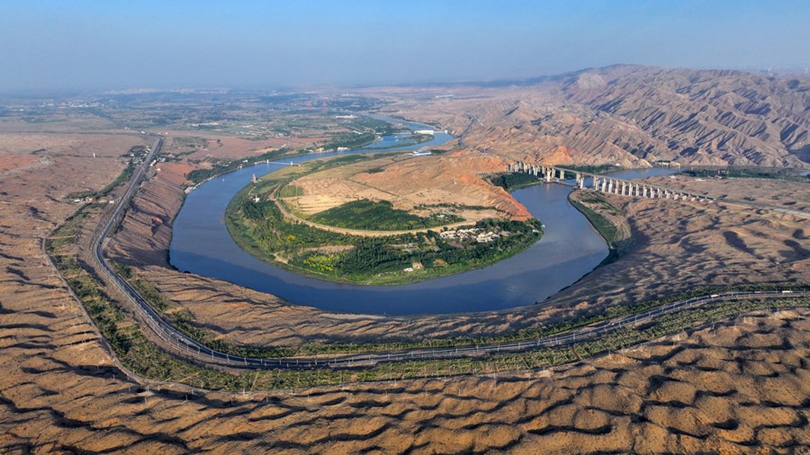
This aerial photo taken on Sept. 6, 2023 shows the Yellow River flowing through Shapotou District in Zhongwei City, northwest China's Ningxia Hui Autonomous Region. [Photo/Xinhua]
China on Monday reached a major milestone in desertification control by completing a barrier belt along the southeastern edge of the Tengger Desert in the northwestern Ningxia Hui Autonomous Region.
In Changliushui village in the city of Zhongwei, workers installed the final row of straw checkerboards, a traditional sand-fixing method, locking the final stretch of shifting dunes in the Ningxia part of the Tengger Desert after a sand control project spanning more than six decades.
This traditional sand-fixing method involves planting straw in a checkerboard pattern on the desert surface to stabilize sand and prevent wind erosion.
This new achievement marks the completion of a 153-kilometer-long green barrier belt in Ningxia, which is 10 to 38 kilometers wide.
Called simply the desert edge-locking project, this approach was designed to fix shifting dunes by planting vegetation belts along the desert's perimeter, preventing further encroachment.
Sand control often suffers setbacks as fixed dunes can start to shift again. To prevent this, workers plan to sow grass and desert-adapted shrubs within the checkerboard grid once the rainy season arrives. Once rooted, the vegetation is expected to lock the sand for the long term.
The belt serves as a natural defense line against the eastward spread of the Tengger Desert, which spans approximately 43,000 square kilometers.
Zhongwei, located between the Qilian and Helan mountains, is the sole gateway for the Tengger Desert's eastward expansion. Experts say the barrier will act as a critical ecological buffer that prevents further sand encroachment and protects the Yellow River.
Lu Qi, chief scientist of the Chinese Academy of Forestry, said the barrier belt can help prevent the desert from further encroaching on farmland, towns, oases and roads, and also significantly reduce the source of sandstorms.
The construction of the green barrier belt in Ningxia dates back to the 1950s when the straw checkerboard approach was invented to protect the Baotou-Lanzhou Railway, China's first desert railway.
Local authorities have worked with research institutions to apply new technologies in sand control, such as artificial cyanobacteria sand crusts and improved straw checkerboards.
Over the past two years, 2.6 billion yuan of investment has been made in the construction of the green barrier belt, part of China's Three-North Shelterbelt Forest Program, the world's largest afforestation program to tackle desertification.
After generations' sand control efforts over the past decades, the city has finished desertification control on about 370,000 hectares of land, pushing the desert back by about 25 kilometers.
"The green barrier belt is not only a means of ecological restoration, but also a key practice of harmonious coexistence between humankind and nature," said Lu. "It also offers an important reference for the sustainable development of arid areas worldwide."
China has taken an active role in global desertification control. Since signing the United Nations Convention to Combat Desertification in 1994, the country has been a leader in halting land degradation and reversing desertification, and has continuously shared sand control experience, technologies and talent abroad.
In its latest effort, the China-Central Asia desertification control cooperation center, which is based in Ningxia, was inaugurated in June to boost international collaboration.
"Our goal is to inject more Chinese momentum into global ecological governance and sustainable development," said Dong Yanbiao, deputy director of the center. He added that the center plans to leverage technology advantages, integrate domestic research and build cooperation networks.


 Share:
Share: 




 京公網(wǎng)安備 11010802027341號(hào)
京公網(wǎng)安備 11010802027341號(hào) 主站蜘蛛池模板:
华坪县|
廊坊市|
鹤庆县|
施甸县|
武冈市|
桑日县|
怀仁县|
乳源|
梨树县|
休宁县|
承德市|
库伦旗|
榕江县|
宝应县|
宜宾市|
武夷山市|
苏州市|
潮州市|
仲巴县|
德清县|
从化市|
彰化市|
肇州县|
峡江县|
习水县|
彭山县|
思茅市|
大英县|
永川市|
长岛县|
灵川县|
信阳市|
禹城市|
常州市|
康乐县|
抚州市|
开江县|
木兰县|
绵竹市|
仪征市|
平顶山市|
主站蜘蛛池模板:
华坪县|
廊坊市|
鹤庆县|
施甸县|
武冈市|
桑日县|
怀仁县|
乳源|
梨树县|
休宁县|
承德市|
库伦旗|
榕江县|
宝应县|
宜宾市|
武夷山市|
苏州市|
潮州市|
仲巴县|
德清县|
从化市|
彰化市|
肇州县|
峡江县|
习水县|
彭山县|
思茅市|
大英县|
永川市|
长岛县|
灵川县|
信阳市|
禹城市|
常州市|
康乐县|
抚州市|
开江县|
木兰县|
绵竹市|
仪征市|
平顶山市|